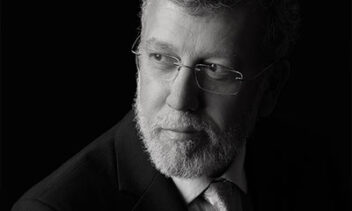No book in human history has had its authorship contested—and no book has had as much at stake—as the Bible. All major religions hinge, to one degree or another, on the Divinity of the Bible. Namely, that it was dictated by God and written by Moses. For centuries, people generally accepted that. But at the end of the seventeenth century, that began to change.
Scholars and novices alike voiced questions about the nature of the text, and broader questions about the very nature of authorship have since entered the conversation as well. What does it mean to be an author? If we were to look at our own lives as a text, is it coherent? Should it be? Maybe life is made up of multiple strands, orientations, stages, that have been stitched together. Does that preclude the notion of having an underlying narrative that animates the text of our lives? Join 18Forty, as we think about Biblical criticism, and these questions, together.
Why are we exploring Biblical criticism and who will we be talking to? Read on.
Why Talk About Dangerous Topics?
Curious readers may wonder – why journey into such weighty, contentious territory? Why not stay in safer waters? Might this not hurt one’s faith? To think through this question, we have to think about the choice – or perhaps the perspective – of faith.
Oliver Wendell Holmes Jr., who served as the Associate Justice on the Supreme Court, is often quoted as saying that “I would not give a fig for the simplicity this side of complexity, but I would give my life for the simplicity on the other side of complexity.” Faith can be simple; faith can be complicated. And perhaps it can be both: there might be a faith on this side of complexity, and a faith on the other side of complexity. One can value the faith on each side of complexity—the texture and merit of a simple faith uninfluenced by the intellectual challenges to faith, as well as the value of a faith hard-earned after engagement with challenge.
Victor Frankl put the question of risk in faith best:
“There is always an element of risk involved in faith. One may spend one’s entire life believing, yet God may remain silent and the loneliness of the soul may never be healed on this earth. Then to affirm that God is “silent in His love” is the highest creative commitment of which a man may be capable. The element of risk is the source of tension that keeps the act of faith forever young. Because of the risk one has to believe every day anew, one has to affirm again and again. Therein lies the essential significance of faith.”
Engaging in conversations around uncomfortable topics is one way to keep one’s faith “forever young,” as Frankl puts it. Faith is an act of courage, and the vulnerability of faith is a testament to the strength of faith—not to its weakness. This month, 18Forty will be thinking about an area of faith that is vulnerable for some, empowering for others, and will do so with insight and perspective about the dangers and possibilities that such conversations pose to faith.
THE FOUR QUESTIONS
Conversation around any topic that is centuries old and that encompass an entire body of literature can not, and should not, end in a day. Biblical criticism is no different – we will not attempt to tell the entire story of Biblical criticism here, but we will offer an entrance point for thinking through these weighty issues.
There are four primary challenges that a critical reader of the Bible will discover: epigraphy, archaeology, lower criticism, and higher criticism. Each of these issues has engendered a broad range of articles, books, and debate. An exhaustive discussion of each, with concrete conclusions, is beyond anything we could reasonably attempt here. Below is simply an introduction to these broad categories in very, very broad strokes and some related materials, as background for our upcoming podcasts, and for further exploration on the part of the reader.
(1) Epigraphy: the contradictions between historical texts and Tanach, like the differences between Kings 2 and the inscription on the Mesha Stele found in ancient Moab, or the lack of records of the subjugation of the Israelites in Egypt. The study of these ancient inscriptions is called epigraphy and is closely linked with the next issue.
(2) Archaeology: the inconsistencies and omissions when comparing the Bible to the archaeological record of the Middle East. For example, there isn’t clear evidence of the Jews ever camping in the desert or existing anywhere outside of Israel, or archaeological evidence suggests that camels were only domesticated far after the Bible purports them to have been used.
When examining these issues, it’s important to consider a few factors. The first is that even in the academic world, these issues are not open and closed. Many Biblical scholars defend the veracity of the Biblical narrative to different degrees, such as Kenneth Kitchen in his book, On the Reliability of the Old Testament, as well as Barry Eichler who states “knowledge gleaned from ancient Near Eastern sources tends to support the biblical accounts in general terms and most of the existing discrepancies can be tolerated” (Study of Bible in Light of Our Knowledge of the Ancient Near East). There have also been accusations of ideological bias both on those seeking to affirm and disprove the Biblical narrative. Today’s scholarly consensus is that at least the later parts of the Bible are historically accurate (for a summary of these findings see Israel Finkelstein’s The Quest for the Historical Israel) and there are scholarly debates about how to incorporate archaeological evidence.
The second factor addresses the nature of archaeology and epigraphy themselves. As Shawn Zelig Aster notes:
The apparent conflict between the biblical narrative and archaeological and epigraphical discoveries is a product of the unrealistic expectation that the events described in the biblical narrative will conform exactly to the events portrayed in archaeological and epigraphic sources. The absurdity of this expectation becomes clear when we reflect on the fact that no narrative narrates every single event taking place in a particular time and space (A Personal Perspective on Biblical History, the Authorship of the Torah, and Belief in Its Divine Origin)
It isn’t always so easy to pin down objectively verifiable conclusions from archaeology and even what can be concluded is always subject to change. For example, the apparent anachronism involving domesticated camels mentioned before was promulgated since the 19th century, but recent archaeological evidence pushed the date of domestication back further (See R. Cohen, Ha-Yishuvim be-Har ha-Negev), which lessened the severity of the challenge. Aster also notes that Tanach isn’t written to be a historical text which may explain some discrepancies. This would explain archaeological findings which suggest major events which go unmentioned in Tanach.
(3) Lower Criticism: the area of study primarily concerned with the accuracy of the text in our modern Chumash, referred to as the Masoretic Text. The Masoretic Text comes from the Aleppo Codex, written in the 10th century CE, and it largely conforms to the text that is referenced in the Talmud, but there are more than a few discrepancies. Rabbi Akiva Eiger, in his glosses to Tractate Shabbos 55a, provides nearly an exhaustive list of such discrepancies. The Talmud and Midrash themselves indicate that the text the Rabbis used in that time contained variations and potential inaccuracies. Even as late as the Middle Ages, the Rabbis were dealing with variations in their texts. This has led to many Bible scholars to propose textual amendments in places where they feel the text has been corrupted, especially if they can support the assertion by pointing to alternative versions such as the Septuagint or Dead Sea Scrolls. By and large, Biblical commentators have been aware of these issues and have dealt with them over time. Their approach suggests that this issue was not perceived as being as fundamental to Jewish faith as the others mentioned here.
(4) Higher Criticism: also known as source criticism, examines the authorship of the Bible. Most scholars take it as a given that the Torah was compiled by multiple authors. They point to parallel narratives with different details or emphasis, or linguistic differences. While scholars disagree about which passages are associated with which authors or how exactly they were canonized together, the overwhelming scholarly consensus is that the Torah is not a unified document, but an amalgamation of many sources compiled over many centuries. This conclusion is derived solely from linguistic and literary analysis as no “proto-bible” has been discovered which would conclusively prove one way or the other. As Joshua Berman notes:
Confronted with the Pentateuch—a text seemingly rife with contradictions—scholars began to consider how such a text could have come to be. The problem with this type of speculation is that we have no documented precursors of the Torah or any of its hypothesized components in the epigraphic record. Scholars can only work backwards from what we have in the Torah today in an attempt to trace its composition and development. (Rethinking Orthodoxy and Biblical Criticism)
The responses to such theories have been varied, but can be arranged into three categories:
The first are responses which argue that the basis for the notion of multiple authors (the discrepancies and redundancies found in narratives and laws) aren’t really discrepancies and redundancies. For example, in the 19th century, Bible scholars sought to identify different strata within the Bible, based on the different names of God. They posited that passages referring to YAWE were written by one person, traditionally named “J”, and passages which invoked ELOHIM were written by another, named “E”. This methodology has largely fallen out of favor because, amongst other things, it is not beyond the realm of possibility to refer to the same god by different names within the same work and one need not resort to suggestions of multiple authorship.
A second approach has been to highlight the remaining questions that arise from such theories. For example, a common theory among Bible scholars is that Deuteronomy was written later than other portions of the Bible, specifically as part of an effort to institute centralized worship in Judaism. This theory is bolstered by several references to worship in the Holy Temple in Deuteronomy (12:13-14), which are absent from other places that mention similar modes of worship (Exodus 20:20). One could question this theory by noting that throughout Deuteronomy, the name of Jerusalem is absent. This makes sense if the passage was written before Jerusalem was settled. However, if it was written after, specifically to enshrine Jerusalem as the central place of worship, then this lacuna is quite glaring. If the answer the Bible critics provide is found to be unsatisfactory, then one could reasonably just leave the question it sought to answer as a peculiarity. Strange literary choices do not prove anything on their own.
It is also worth noting that there is evidence to support the traditional version of the Bible. Yoel Elitzur notes, quoting the work of Avi Hurvitz, on the basis of comparative linguistic analysis, he [Avi Hurvitz] convincingly demonstrated that the cultic terminology of the “priestly” chapters in Exodus, Leviticus, and Numbers is completely different from that of parallel texts in Ezekiel, Ezra, and Chronicles, a factor that reduces the probability that any of the former were written at the same time of the latter. (The Names of God and the Dating of the Biblical Corpus).
Additionally, David Berger notes that there are places in the Bible where consistent word choices, themes, and parallelisms repeat in multiple places, suggesting they are designed to be read in light of each other. Berger explains “It is becoming clearer from year to year that Genesis is replete with linguistic and thematic patterns of subtlety and power which run through the warp and woof of the entire work” and points out “You can allow the ‘redactor’ just so much freedom of action before he turns into an author” (On the Morality of the Patriarchs in Jewish Polemic and Exegesis). This is especially poignant since most Bible critics assume the ‘redactor’ to have complete ignorance to the agendas of the original authors.
There is a third option available and that is to offer alternative explanations to the critics’ questions. A famous example of this is in Lonely Man of Faith, where Rabbi Joseph B. Soleveitchik notes that the creation of man is written in two drastically different ways. He posits that this is intentional and is meant to reflect the two sides of Man, which he dubs “Adam I and Adam II.” Building upon this theory, Rabbi Mordechai Breuer (who is most famous for developing Torah commentary directly influenced by the observations of Bible critics) posits that the Torah was written with different voices or “aspects”. These function as a powerful literary technique in which multiple perspectives of an issue can be fleshed out. Rabbi Shalom Carmy notes a similar phenomenon wherein, “great writers are eminently capable of employing multiple styles: the stylistic variations among Kierkegard’s ‘pseudonyms’, for example, are so thorough-going that they show up on computer analysis” (Introducing Rabbi Breuer). Rabbi Breuer ultimately thought that the questions raised by Bible critics ultimately had little bearing on a person’s belief in the divinity of the Bible. As he says,
The man of science sees in the Torah a collection of documents, written by J, E, D, P, and redacted later on by R … The man of great faith, in contrast, sees in the Torah the work of God. This man believes that God Himself wrote J, E, D, and P, and He Himself also took on R’s redaction work. (Shitat ha-Bechinot shel Ha-Rav Mordekhai Breuer)
Tune in to this introductory episode to Biblical Criticism.








